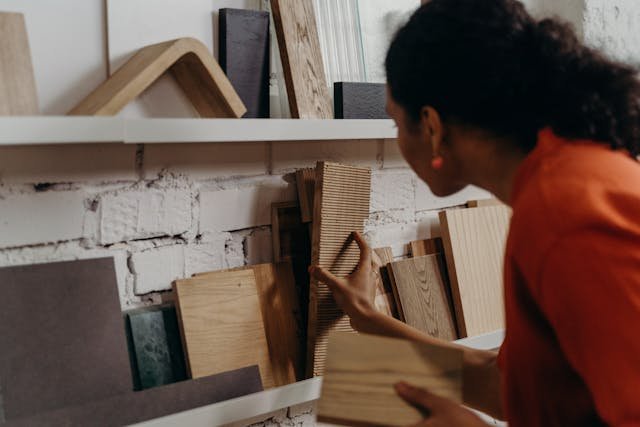
Interior design is frequently misrepresented as purely a visual pursuit, centered exclusively on aesthetics. However, there’s so much more beneath the surface.
Every design decision is rooted in a deeper intention and the psychology of our environment. Many people overlook the fact that the true success of a room lies not in its appearance, but in the emotions it evokes.
The spaces we inhabit—whether personal or professional—have an incredible ability to influence our feelings, routines, and interactions with others. A simple adjustment, such as the placement of a chair, the color of a wall, or the form of a lamp, can uplift, energize, or even foster introspection. Often, our reactions to the spaces we occupy are profound, even if we are not consciously aware of them.
It’s in the subtle changes within a space that the true magic occurs. This journey begins with a thorough understanding of the hidden psychology that guides our design choices.
Colors: The Unseen Mood Influencer
Color is a fundamental aspect of interior design, often the first thought that comes to mind when planning a home. Its significant influence on our perception of space is no coincidence; color impacts much more than our visual experience.
Every hue carries emotional connotations—some can calm or invigorate, while others can uplift or ground us. Color markedly shapes our experience of our surroundings.
For instance, the tranquil vibes of soft blues and gentle greys are often featured in relaxation areas because we associate these colors with peace and serenity.
Conversely, kitchens and creative spaces often embrace vibrant yellows and oranges to infuse a sense of vitality and energy.
The emotional ambiance desired in a space should guide your color selection. By defining the mood you want to achieve, you can research color psychology and your personal perceptions to inform your design decisions.
Spatial Arrangement: The Foundation of Comfort and Flow
Here, we refer not to square footage, but to the form, content, and organization of your space. The chosen layout sends subtle messages to the brain regarding openness, intimacy, security, and practicality.
Furniture arrangement plays a crucial role in this dynamic. For example, a circular seating arrangement invites conversation and connection, while a single chair angled toward a window creates a serene retreat. Even minor choices, such as pulling furniture away from walls or utilizing area rugs to delineate zones, can significantly alter how individuals navigate and engage with a space.
Visual elements like mirrors and artwork can transform spatial perception dramatically. Positioning mirrors opposite windows can amplify natural light and create an illusion of depth, while large-scale art can attract the eye and enhance the sense of height and interest in a room.
Ultimately, mastering spatial flow hinges on your ability to interpret the emotional needs of each area and respond appropriately. When the layout aligns with these needs, the space resonates with harmony.
Enriching the Senses Through Shape and Texture
But the journey doesn’t end with color and layout. Our sensory experience is also significantly influenced by forms. Geometric designs in frames, ceramics, decorative pieces, or abstract art subtly influence our mood and behavior. Soft, curved lines offer comfort and relaxation, whereas angular shapes promote clarity, energy, and a sense of purpose.
Texture is another pivotal element in interior design that adds emotional depth. The luxurious feel of velvet, the authentic appeal of raw wood, or the sleekness of polished concrete transcends mere decoration—they become emotional anchors.
A well-balanced interplay of shapes and textures creates an environment that encourages deeper feelings and connections with our surroundings.
Shaping Emotion and Routine Through Light
Have you ever walked into a space and thought, “Wow, the lighting is amazing!”? You’re not alone. Many don’t realize that light is one of the most powerful yet frequently underestimated tools in interior design. It can profoundly affect our feelings and daily routines.
Natural light regulates our circadian rhythms, boosting energy levels in the morning and aiding relaxation in the evening. Conversely, poorly planned artificial lighting can disrupt this rhythm, leading to fatigue, irritability, and sleep disturbances.
Interior design professionals often advocate for layered lighting—combining ambient (general), task (functional), and accent (decorative) lighting—to create adaptable spaces that respond to our emotional needs.
Designing with Memory and Emotion
You now understand that design is not merely about aesthetics; it’s about evoking the right feelings. Yet, meaningful design also tells a story—specifically, your story.
Sentimental items, cherished heirlooms, and familiar fragrances transform houses into homes, triggering memories, reflecting identity, and offering a comforting sense of continuity in our lives.
Interestingly, nostalgia can significantly enhance our well-being. Incorporating emotional anchors, like a vintage vase from a grandparent or the scent of lavender, provides reassurance, grounding us in what truly matters and reminding us of our essence.
Behavioral Design: Shaping Our Actions
Each room inherently encourages specific behaviors, often without our conscious realization. A beautifully designed kitchen beckons us to gather for meals, while a tidy entryway facilitates a smoother transition from the chaos outside to the calm within.
With intentional design choices, you can promote healthier habits. For instance, place a cozy reading chair by a window, and you’ll find it invites moments of pause.
Ultimately, it comes down to aligning design intentions with desired outcomes. Do you envision a space that fosters introspection or one that encourages social interactions? The way you shape your surroundings inevitably influences how you engage with them.
The Emotional Framework of Every Room
Exceptional design is fundamentally about feeling. Every detail, from color to layout, contributes to the emotional melody you create in your space. By making intentional choices, you cultivate a home that nurtures your mood, habits, and overall lifestyle.
So, what’s the underlying psychology of interior design? It involves taking the time to reflect and delving deeper than mere aesthetics. These insights are pivotal in transforming spaces and influencing the lives we lead within them.







